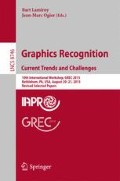Abstract
Product graph has been shown as a way for matching subgraphs. This paper reports the extension of the product graph methodology for subgraph matching applied to symbol spotting in graphical documents. Here we focus on the two major limitations of the previous version of the algorithm: (1) spurious nodes and edges in the graph representation and (2) inefficient node and edge attributes. To deal with noisy information of vectorized graphical documents, we consider a dual edge graph representation on the original graph representing the graphical information and the product graph is computed between the dual edge graphs of the pattern graph and the target graph. The dual edge graph with redundant edges is helpful for efficient and tolerating encoding of the structural information of the graphical documents. The adjacency matrix of the product graph locates the pair of similar edges of two operand graphs and exponentiating the adjacency matrix finds similar random walks of greater lengths. Nodes joining similar random walks between two graphs are found by combining different weighted exponentials of adjacency matrices. An experimental investigation reveals that the recall obtained by this approach is quite encouraging.
Access this chapter
Tax calculation will be finalised at checkout
Purchases are for personal use only
Notes
- 1.
- 2.
- 3.
For all the qualitative results the interested readers are referred to http://www.cvc.uab.es/~adutta/Research/ProductGraph/res_rw.php.
References
Aziz, F., Wilson, R.C., Hancock, E.R.: Backtrackless walks on a graph. IEEE Trans. Neural Networks Learn. Syst. (TNNLS) 24(6), 977–989 (2013)
Delalandre, M., Pridmore, T.P., Valveny, E., Locteau, H., Trupin, É.: Building synthetic graphical documents for performance evaluation. In: Liu, W., Lladós, J., Ogier, J.-M. (eds.) GREC 2007. LNCS, vol. 5046, pp. 288–298. Springer, Heidelberg (2008)
Dutta, A., Gibert, J., Lladós, J., Bunke, H., Pal, U.: Combination of product graph and random walk kernel for symbol spotting in graphical documents. In: Proceedings of the International Conference of Pattern Recognition (ICPR), pp. 1663–1666 (2012)
Dutta, A., Lladós, J., Pal, U.: A symbol spotting approach in graphical documents by hashing serialized graphs. Pattern Recogn. (PR) 46(3), 752–768 (2013)
Fischer, A., Suen, C.Y., Frinken, V., Riesen, K., Bunke, H.: A fast matching algorithm for graph-based handwriting recognition. In: Kropatsch, W.G., Artner, N.M., Haxhimusa, Y., Jiang, X. (eds.) GbRPR 2013. LNCS, vol. 7877, pp. 194–203. Springer, Heidelberg (2013)
Gärtner, T., Flach, P.A., Wrobel, S.: On graph kernels: hardness results and efficient alternatives. In: Schölkopf, B., Warmuth, M.K. (eds.) COLT/Kernel 2003. LNCS (LNAI), vol. 2777, pp. 129–143. Springer, Heidelberg (2003)
Ming-Kuei, H.: Visual pattern recognition by moment invariants. IRE Trans. Inf. Theor. 8(2), 179–187 (1962)
Lladós, J., Valveny, E., Sánchez, G., Martí, E.: Symbol recognition: current advances and perspectives. In: Blostein, D., Kwon, Y.-B. (eds.) GREC 2001. LNCS, vol. 2390, pp. 104–128. Springer, Heidelberg (2002)
Mahé, P., Ueda, N., Akutsu, T., Perret, J.-L., Vert, J.-P.: Graph kernels for molecular structure-activity relationship analysis with support vector machines. J. Chem. Inf. Model. (JCIM) 45(4), 939–951 (2005)
Stark, H.M., Terras, A.A.: Zeta functions of finite graphs and coverings. J. Adv. Math. (JAM) 121(1), 124–165 (1996)
Acknowledgements
This work has been partially supported by the Spanish projects TIN2009-14633-C03-03, TIN2011-24631, TIN2012-37475-C02-02, 2010-CONE3-00029 and the PhD scholarship 2013FI_B2 00074.
Author information
Authors and Affiliations
Corresponding author
Editor information
Editors and Affiliations
Rights and permissions
Copyright information
© 2014 Springer-Verlag Berlin Heidelberg
About this paper
Cite this paper
Dutta, A., Lladós, J., Bunke, H., Pal, U. (2014). A Product Graph Based Method for Dual Subgraph Matching Applied to Symbol Spotting. In: Lamiroy, B., Ogier, JM. (eds) Graphics Recognition. Current Trends and Challenges. GREC 2013. Lecture Notes in Computer Science(), vol 8746. Springer, Berlin, Heidelberg. https://doi.org/10.1007/978-3-662-44854-0_2
Download citation
DOI: https://doi.org/10.1007/978-3-662-44854-0_2
Published:
Publisher Name: Springer, Berlin, Heidelberg
Print ISBN: 978-3-662-44853-3
Online ISBN: 978-3-662-44854-0
eBook Packages: Computer ScienceComputer Science (R0)

